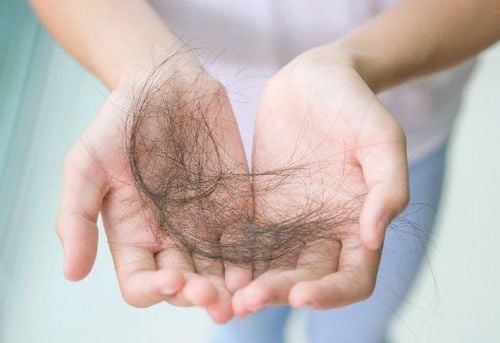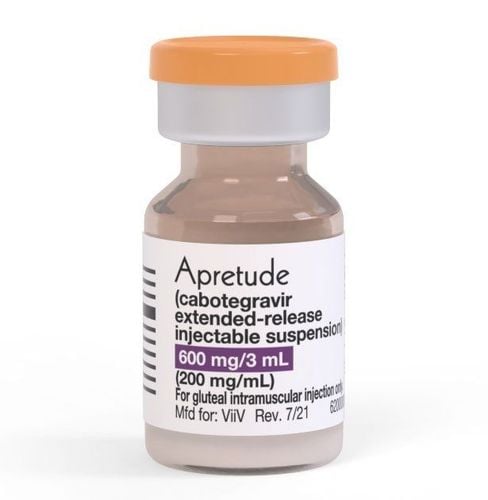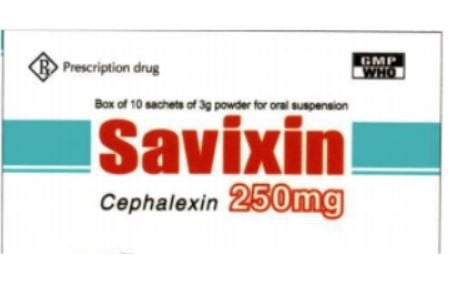This is an automatically translated article.
Translated and synthesized by Dr. Nguyen Hong Thanh - VinmecResearch Institute of Stem Cells and Gene Technology
Ebola virus belongs to the genus Ebolavirus, capable of infecting and causing disease in humans, primates including monkeys, gorillas and chimpanzees. Ebola virus disease has a high mortality rate in humans with a mortality rate of up to 50% of infections.
Ebola virus can be transmitted from person to person and outbreaks into epidemics through direct contact through skin or mucosal wounds with blood, secretions and body fluids (faeces, urine, saliva, semen). ) of the infected person. People can also get Ebola by coming into contact with contaminated patient equipment or objects such as used clothing, blankets, needles, etc.
Below are the diagnostic and therapeutic signs of Ebola virus disease. according to the instructions of the Ministry of Health.
1. Diagnosis of Ebola virus disease
Diagnosis of suspected case: Epidemiological factors within 3 weeks prior to symptom onset such as:
Contact with blood or body fluids of a patient with confirmed or suspected Ebola virus infection. Live in or travel to an Ebola-endemic area. Direct handling, contact with bats, rats or primates from endemic areas. Clinical manifestations of the disease

Chẩn đoán bệnh do virus Ebola thông qua triệu chứng mắc phải
Diagnosis of confirmed case: A suspected and confirmed case of Ebola virus gene detection by PCR technique.
Differential diagnosis: Ebola virus disease needs to be distinguished from other diseases such as:
Dengue hemorrhagic fever Streptococcus suis Meningococcal septicemia Leptospira septic shock and infection Complicated malaria

Cần chẩn đoán phân biệt với bệnh sốt rét có biến chứng
2. Treatment of Ebola virus disease
Treatment principles:
There is no specific treatment, mainly supportive treatment. Suspected cases must be examined at a hospital, isolated, and sampled to be sent for specific tests to diagnose the disease. For confirmed cases, it is necessary to be hospitalized for treatment and completely isolated.
Symptoms of Ebola virus disease are treated as they appear. When used early, basic interventions can greatly improve the chances of survival, including:
Providing fluids and electrolytes (body salts) through intravenous infusion (intravenously) Give oxygen therapy to maintain oxygen status Use medication to support blood pressure, reduce vomiting and diarrhea, and to control fever and pain Treat other infections
Take antiviral medication
Currently none There are antiviral drugs approved by the U.S. Food and Drug Administration (FDA) to treat EVD in humans. However, during the outbreak in the Democratic Republic of Congo in 2018, four drugs were tested for patients with the disease. Two of these four drugs, regeneron (REGN-EB3) and mAb114, had higher survival rates than the other two drugs. Currently, these two Ebola antiviral drugs are still used in patients with confirmed Ebola.
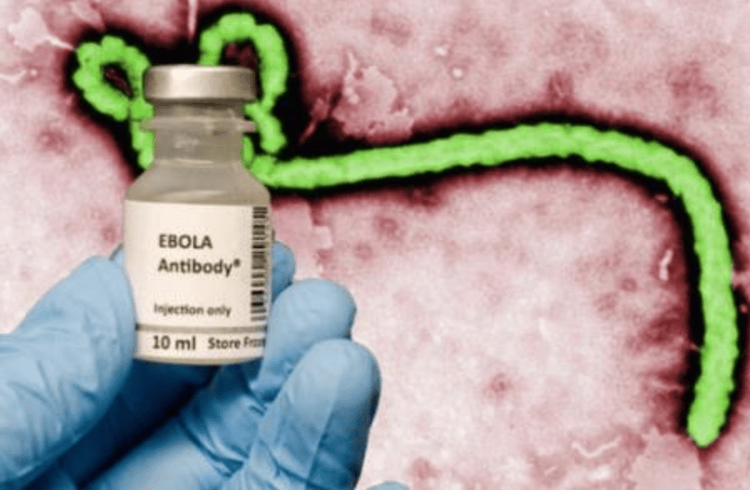
Sử dụng thuốc kháng virus trong điều trị bệnh do virus Ebola
3. How to protect and prevent
The Department of Preventive Medicine, the Ministry of Health recommends that people take the following measures: An effective preventive measure is to practice personal hygiene, wash hands frequently with soap and antiseptic solution; Avoid direct contact with blood, secretions, objects of infected people or animals or objects that may have come into contact with blood and secretions of infected people and animals; Restricting non-essential travel to Ebola-affected countries; If you have to go, need to find out information about the Ebola epidemic at the destination to take measures to prevent infection for yourself; Limit direct contact with people infected with Ebola; when it is necessary to contact, it is necessary to wear a medical mask, wear protective clothing properly and keep a distance when in contact. People returning from countries with epidemics, within 21 days if showing signs of fever, fatigue, muscle aches, headache, sore throat, diarrhea, rash, etc., should immediately go to the nearest medical facility. for consultation, examination and testing. Make declarations, information and case reports according to the instructions of the Ministry of Health, or call the hotline numbers of the Ministry of Health: 19009095 and 19003228.
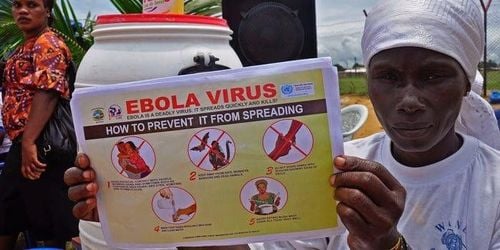
Cách phòng ngừa sự lây nhiễm của Ebola (nguồn: Abbas Dulleh / AP)
For patients Isolated, treated at medical facilities under the guidance of the Ministry of Health. Use the correct personal protective equipment to limit disease transmission. Limit contact, transport patients, in case of need to transport, use personal protective equipment and specialized vehicles. Contaminated items, discarded items, and patient waste should be disinfected and disposed of according to regulations. Ebola virus continues to be excreted in semen and breast milk, so it is important to counsel patients on how to prevent transmission after discharge from the hospital. Handling of corpses according to Circular No. 02/2009/TT-BYT dated May 26, 2009 of the Minister of Health guiding hygiene in burial and cremation activities.
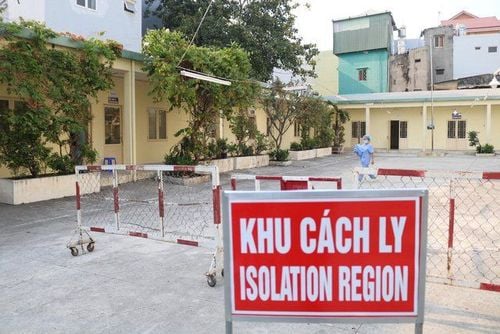
Người bệnh cần được cách ly
For people in close contact: Patient caregivers must take personal protective measures (N95 mask, eye protection, hat, gloves, shoes, clothes) wash hands immediately with soap or other antiseptic solution after each contact with the sick person. Minimize contact with patients. Practice good personal hygiene, frequently wash hands with soap; use of oral antiseptics. Make a list of close contacts and monitor their health for 21 days from last contact. Counseling contacts about signs of disease and prevention and control measures for self-prevention, self-monitoring and early detection of symptoms of Ebola. If symptoms of the disease appear, it is necessary to immediately notify the nearest medical facility for timely diagnosis and treatment. Infection prevention and control at treatment facilities: Strictly implementing the stream of patient examination, isolation and treatment, infection control measures, and personal protective equipment for medical staff and caregivers. take care of patients and other patients at patient treatment facilities under the guidance of the Ministry of Health.
Recommended video
Instructions on how to properly wash your hands to prevent viral infection
Disinfection for treatment of the environment and hospital waste: Comply with the process of environmental and waste treatment as prescribed as for the isolation area for other dangerous infectious diseases.
3. Vaccines against Ebola virus
December 19, 2019, the US Food and Drug Administration officially approved Evebo vaccine to prevent Ebola caused by Zaire ebolavirus (one of the first two strains of Ebola virus disease). in Africa since 1976). This vaccine is approved for use in adults 18 years of age and older. This is an important step forward for a group of American scientists in the research and development of a vaccine against Ebola. In the US, Ebola cases are rare, but the risk of infection is very high from travelers (source FDA).
4. Disease developments
Since the first discovery of the Ebola virus in 1976, Ebola virus infections and outbreaks have mainly occurred in Africa. The 2014-2016 Ebola outbreak in West African countries began in rural southeastern Guinea, spread to urban areas and across borders within weeks, and became an epidemic. global disease within a few months.
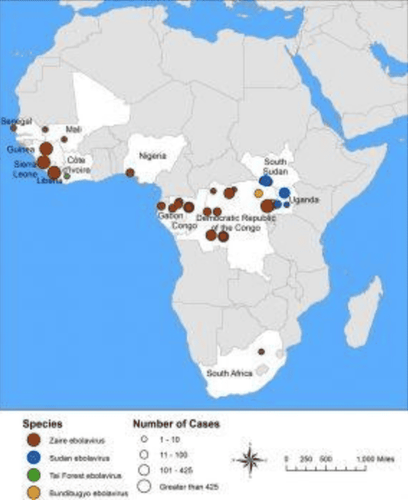
Bản đồ lây lan dịch bệnh Ebola năm 2014-2016 tại châu Phi
From 1976 to the time of statistics in September 2019, there were more than 30,000 people infected and more than 11,000 people died from Ebola. The disease started in the Democratic Republic of the Congo, then spread to other African countries such as Gabon, Ivory Coast, South Sudan, Uganda, Guinea, Liberia and Sierra Leone. In 2014, Ebola began to spread to the United States.
Sources: WHO, CDC, FDA, Ministry of Health
MORE:
What to know about Ebola virus disease Where did Ebola outbreak occur? How is Ebola virus transmitted?








